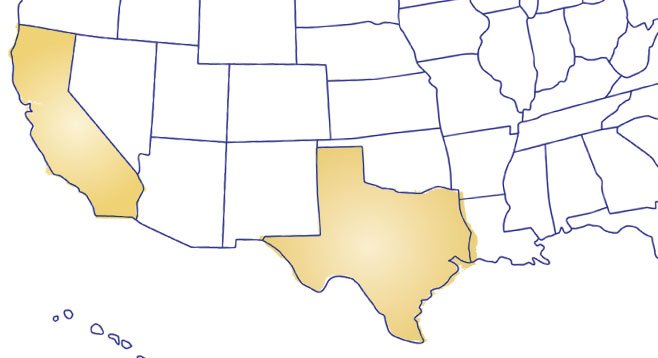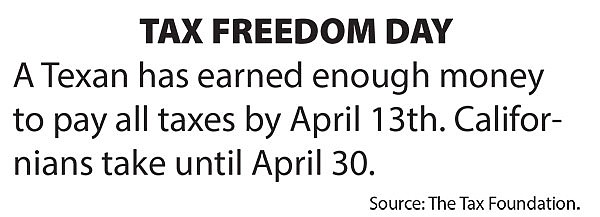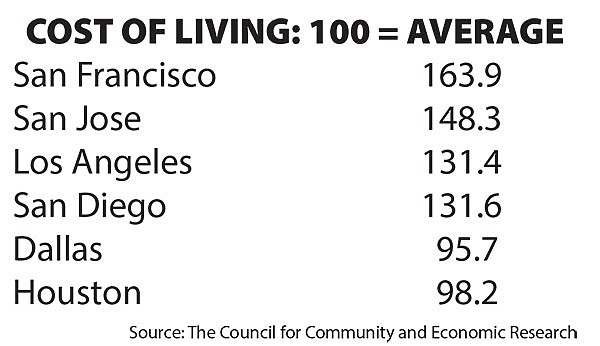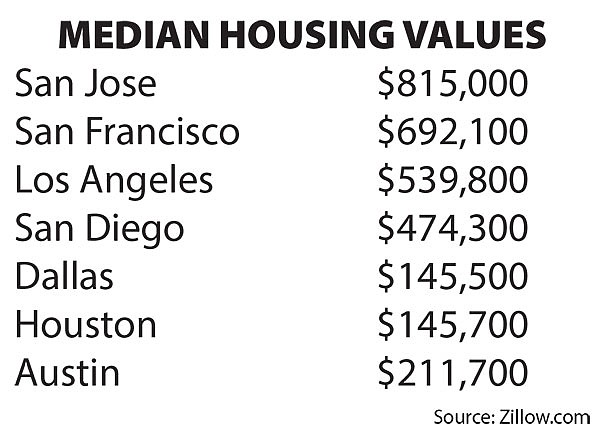 Facebook
Facebook
 X
X
 Instagram
Instagram
 TikTok
TikTok
 Youtube
Youtube

Texas is a blue state. “What?!” you shriek. Texas is one of the reddest of the red Republican states. I mean that Texas is a blue-collar state. And its strategy for wooing companies to relocate there helps make it so. Texas governor Rick Perry goes all around the country trying to get companies to move to Texas, which, among other things, has no income tax. Texas holds down labor unions and wages, has a low cost of living with low housing prices, and has weak regulation, boasts Perry.


But, hold on. Perhaps lower taxes, cheap labor, low-price homes, and ineffective regulation aren’t what smart companies seek. Indeed, I recently came across some eye-opening data. The accounting firm PricewaterhouseCoopers each quarter publishes numbers on how much venture capital is invested in various metro areas around the United States.

Venture capital is money provided to early-stage start-up companies that often can’t get funds from traditional sources. The venture capitalist isn’t offering the young company a loan. He or she is giving the money in return for a stake in the budding firm. If the company is successful and goes public, the venture capitalist can rake in a bundle. If the company is not successful, the venture capitalist can lose. Most of these venture-capital investments go into cerebral companies — in high-tech, biotech, telecom, software, and the like.
Through the first half of this year, about $13.6 billion of venture capital poured into California. Texas took in $700 million.
Get this: San Diego collected $484 million — almost as much as the whole state of Texas. There were 52 deals in San Diego, 88 in Texas.
Silicon Valley got $12 billion of California’s $13.6 billion. The Los Angeles area, including Orange County, got more than $1 billion.
What do these numbers show? “There is not a lot of innovation going on in Texas,” says Philip Mattera, research director of the Washington DC–based Good Jobs First, an organization that opposes states trying to woo companies from other parts of the country. “Part of their appeal is low regulation, cheap labor, few unions. These don’t appeal to start-ups doing innovative things. Those companies want the most creative people, and there aren’t as many in Texas as there are in California.”

Says Kelly Cunningham, economist for the National University System Institute for Policy Research, “People want to live in California for the climate, ocean, culture, Pacific Rim location.” California is the home for “the freethinker, the outside-the-box thinker. California is a place of innovation, new ideas. Texas has a different mindset.”
Because Texas has lower wages, it’s attractive for the company “looking for the factory-type worker,” says Cunningham.
California has “intellectual capital,” says Cunningham. In my opinion, Texas has anti-intellectual capital. One proof of that is its governor, Rick Perry. The state runs ads poking fun at “big-government” (blue) states. But Texas woos companies in those “big-government” states with — you guessed it — big-government money. Texas showers money on companies that relocate there through the Texas Economic Development Act, the Emerging Technology Fund, and the Texas Enterprise Fund. They cost taxpayers tens of millions of dollars a year.
These subsidies have stirred up a lot of controversy within the state. As Mattera points out, the Texas Enterprise Fund and Emerging Technology Fund, controlled by the governor, have been widely accused of steering subsidies to companies that are big campaign contributors. Companies taking the relocation subsidies are supposed to create jobs. But when they don’t, Perry is likely to let them off the hook, says Mattera.
For the most part, companies relying on brainpower remain in California, even though the state isn’t generous with subsidies, compared with Texas.
From a purely economic standpoint, however, Texas has many advantages over California. Housing values and cost-of-living comparisons are startling.

For example, San Diego and Dallas have just about the same median household income — $47,000 a year. But according to the Council for Community and Economic Research, San Diego’s cost of living is 31.6 percent above the nation’s. Dallas’s cost of living is 4.3 percent below the nation’s. According to Zillow.com, the median home price in San Diego is $474,300. In Dallas, it’s $145,500. According to Payscale.com, if you earn $60,000 a year in San Diego, you can maintain the same living standard in Dallas for $44,099 a year and in Austin for $42,893.
Now look at Silicon Valley. The San Jose median home price is a whopping $815,000, highest among the nation’s 35 largest metro areas. In Houston it’s only $145,700 and in Austin $211,700. The people in Silicon Valley stay there because that’s where the jobs are and that’s where the lifestyle is. The companies want to stay because that’s where the talent is — and no thanks to cheap labor and low taxes.
Of course, the salaries are higher in the center of technology, too. Median household income in the Bay Area (San Francisco, Oakland, San Jose) is $63,024, highest in the nation. That takes some of the sting out of the high cost of living. Houston’s median household income is $44,761, and its cost of living is 1.8 percent below the nation’s.
California’s 13.3 percent top income-tax rate, 8.84 percent corporate-tax rate, and $1426 property-tax collections per capita make it one of the highest-tax states in the nation, says the Tax Foundation. Texas has no income tax, but its property-tax collection per capita, at $1557, is higher than California’s.
Warns Cunningham, “At some point, California’s attractive lifestyle, high home prices, [tough] regulation, and high taxes have an impact.” In fact, that may be happening now. “In the last five years, [San Diego’s] population of 35- to 49-year-olds has decreased 4.6 percent. Those wanting to buy a house and have a family are looking at the housing market and seeing they can’t afford it.” The population of those 0 to 19 years of age has declined almost 2 percent in the same period. Cunningham thinks those leaving are going to other Western states, including Texas.
But history shows that people go where the jobs are. And as long as the companies wanting creative techies stay in California, despite the costs, the best and brightest will continue to come to this state.


Texas is a blue state. “What?!” you shriek. Texas is one of the reddest of the red Republican states. I mean that Texas is a blue-collar state. And its strategy for wooing companies to relocate there helps make it so. Texas governor Rick Perry goes all around the country trying to get companies to move to Texas, which, among other things, has no income tax. Texas holds down labor unions and wages, has a low cost of living with low housing prices, and has weak regulation, boasts Perry.


But, hold on. Perhaps lower taxes, cheap labor, low-price homes, and ineffective regulation aren’t what smart companies seek. Indeed, I recently came across some eye-opening data. The accounting firm PricewaterhouseCoopers each quarter publishes numbers on how much venture capital is invested in various metro areas around the United States.

Venture capital is money provided to early-stage start-up companies that often can’t get funds from traditional sources. The venture capitalist isn’t offering the young company a loan. He or she is giving the money in return for a stake in the budding firm. If the company is successful and goes public, the venture capitalist can rake in a bundle. If the company is not successful, the venture capitalist can lose. Most of these venture-capital investments go into cerebral companies — in high-tech, biotech, telecom, software, and the like.
Through the first half of this year, about $13.6 billion of venture capital poured into California. Texas took in $700 million.
Get this: San Diego collected $484 million — almost as much as the whole state of Texas. There were 52 deals in San Diego, 88 in Texas.
Silicon Valley got $12 billion of California’s $13.6 billion. The Los Angeles area, including Orange County, got more than $1 billion.
What do these numbers show? “There is not a lot of innovation going on in Texas,” says Philip Mattera, research director of the Washington DC–based Good Jobs First, an organization that opposes states trying to woo companies from other parts of the country. “Part of their appeal is low regulation, cheap labor, few unions. These don’t appeal to start-ups doing innovative things. Those companies want the most creative people, and there aren’t as many in Texas as there are in California.”

Says Kelly Cunningham, economist for the National University System Institute for Policy Research, “People want to live in California for the climate, ocean, culture, Pacific Rim location.” California is the home for “the freethinker, the outside-the-box thinker. California is a place of innovation, new ideas. Texas has a different mindset.”
Because Texas has lower wages, it’s attractive for the company “looking for the factory-type worker,” says Cunningham.
California has “intellectual capital,” says Cunningham. In my opinion, Texas has anti-intellectual capital. One proof of that is its governor, Rick Perry. The state runs ads poking fun at “big-government” (blue) states. But Texas woos companies in those “big-government” states with — you guessed it — big-government money. Texas showers money on companies that relocate there through the Texas Economic Development Act, the Emerging Technology Fund, and the Texas Enterprise Fund. They cost taxpayers tens of millions of dollars a year.
These subsidies have stirred up a lot of controversy within the state. As Mattera points out, the Texas Enterprise Fund and Emerging Technology Fund, controlled by the governor, have been widely accused of steering subsidies to companies that are big campaign contributors. Companies taking the relocation subsidies are supposed to create jobs. But when they don’t, Perry is likely to let them off the hook, says Mattera.
For the most part, companies relying on brainpower remain in California, even though the state isn’t generous with subsidies, compared with Texas.
From a purely economic standpoint, however, Texas has many advantages over California. Housing values and cost-of-living comparisons are startling.

For example, San Diego and Dallas have just about the same median household income — $47,000 a year. But according to the Council for Community and Economic Research, San Diego’s cost of living is 31.6 percent above the nation’s. Dallas’s cost of living is 4.3 percent below the nation’s. According to Zillow.com, the median home price in San Diego is $474,300. In Dallas, it’s $145,500. According to Payscale.com, if you earn $60,000 a year in San Diego, you can maintain the same living standard in Dallas for $44,099 a year and in Austin for $42,893.
Now look at Silicon Valley. The San Jose median home price is a whopping $815,000, highest among the nation’s 35 largest metro areas. In Houston it’s only $145,700 and in Austin $211,700. The people in Silicon Valley stay there because that’s where the jobs are and that’s where the lifestyle is. The companies want to stay because that’s where the talent is — and no thanks to cheap labor and low taxes.
Of course, the salaries are higher in the center of technology, too. Median household income in the Bay Area (San Francisco, Oakland, San Jose) is $63,024, highest in the nation. That takes some of the sting out of the high cost of living. Houston’s median household income is $44,761, and its cost of living is 1.8 percent below the nation’s.
California’s 13.3 percent top income-tax rate, 8.84 percent corporate-tax rate, and $1426 property-tax collections per capita make it one of the highest-tax states in the nation, says the Tax Foundation. Texas has no income tax, but its property-tax collection per capita, at $1557, is higher than California’s.
Warns Cunningham, “At some point, California’s attractive lifestyle, high home prices, [tough] regulation, and high taxes have an impact.” In fact, that may be happening now. “In the last five years, [San Diego’s] population of 35- to 49-year-olds has decreased 4.6 percent. Those wanting to buy a house and have a family are looking at the housing market and seeing they can’t afford it.” The population of those 0 to 19 years of age has declined almost 2 percent in the same period. Cunningham thinks those leaving are going to other Western states, including Texas.
But history shows that people go where the jobs are. And as long as the companies wanting creative techies stay in California, despite the costs, the best and brightest will continue to come to this state.
Comments